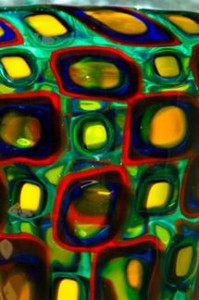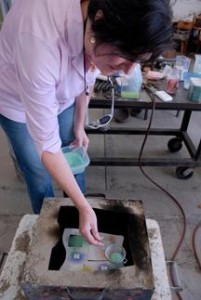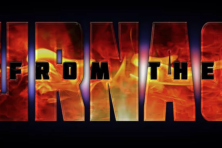Door County Arts: The Fiery Furnace
- Share
- Tweet
- Pin
- Share
To anyone who might potentially complain about their heating bill this winter, take note – Jeremy Popelka and Stephanie Trenchard’s furnace in their gallery and glass studio is on 50 weeks out of the year.
“We shut it off for holidays,” Jeremy Popelka laughs. “But that’s about it.”
The Popelka Trenchard studio is in a renovated storefront/garage that used to be the information headquarters for Peterson Builders, Inc., a former shipbuilding company. Before that, the building served as the Wisconsin Public Service building where, ironically enough, there was a gas stove showroom where the gallery portion exists now. It’s a wonderful industrial space, one that you’d almost expect to house an underground theatre performance of some sort. And seeing that the art of glass really is theatrics, at least for Stephanie Trenchard, this analogy would be appropriate.

“Glass making really is theatrical,” says Trenchard. “Once you start a piece, you have to see it all the way through to the end – you can’t take a break. I like the give and take between the masculinity and femininity of it all – you have to put up with a lot of pain to create your piece, but then you end up with a beautiful piece and it makes it all worth it.”
In talking with Popelka and Trenchard about their work, it seems that all of the steps they took to get to Door County have been more than “worth it.” Popelka had begun his glass career by attending the Pilchuck School, a prestigious glass school located in Washington State. From there, he attended Illinois State University, where he would meet Stephanie. Both graduated with a Bachelor of Fine Arts Degree – Popelka with a concentration in glass and Trenchard in painting. The couple departed for Oakland, California, where Popelka earned a master’s degree at the California College of Arts and Crafts.

“It was an exciting time for glass art,” Trenchard says. “When Jeremy was attending school, studio glass was a very small part of the art world, although it was an art form that was gaining notoriety very fast. The well-known glass artists were still very attainable – you were actually able to meet these people that you read about.” The couple lived in California’s Bay Area until 1997, when they decided to make a move to a place they had both visited as kids – Door County.
Popelka Trenchard got its start in Door County through the Door County Business Development Center business incubator facility, which is housed in the Sturgeon Bay Industrial Park. They stayed in that location until January 2003, when the studio and gallery was relocated to their present location in Sturgeon Bay. Before the move to Door County, Trenchard had been interested in her husband’s work, but had never dabbled in it herself. On a whim, she created and fired a few pieces of her own in their new studio space and promptly fell in love.
“I began to realize that glass art could be poetic and narrative – just like painting,” she says.

The process of glassmaking certainly is a narrative in itself. While some glass artists prefer to make their own glass mixture, Popelka and Trenchard prefer to purchase glass in pellet form and then “liquefy” the glass with heat. That furnace in the studio that is always on? It actually holds 300 pounds of molten, liquid glass.
Raw color is added to the clear, colorless glass – a small piece of raw color is chiseled off and added to a particular piece. “The colors come from New Zealand and Europe,” says Popelka, “and all of the color we use needs to be highly compatible with the type of glass we use. If it isn’t, the colors will actually crack the glass.”
Since glass cools quickly while it is being worked on, two smaller furnaces, called “gloryholes,” keep any pieces pliable that are being worked on. Two ceramic kilns near the furnace are used for cooling the work down once it is finished.

While there are a lot of different methods to create a piece of glass art, the one that seems to be included in many of Popelka and Trenchard’s pieces is the method of sand casting. Sand casting involves the use of hot molten glass that is poured directly into a preformed mold, similar to the process of casting metal into a mold. The surface of the preformed mold is covered in sand, which gives a certain color and texture to the sand cast glass object. Hot glass is ladled from the furnace and poured directly into the mold. Smaller glass pieces or other comparable glass objects can be placed into the work to make it look as if the smaller objects are floating in solid glass.
Although the methods employed by the couple are very similar, the subjects and inspirations that motivate the couple are very different. While both create functional glass art, Popelka and Trenchard also have their own specific niches in terms of decorative art. Having been raised in rural Illinois, Popelka is influenced by certain architectural, organic, and geological properties, the most common of these being the architecture of the farm. “There is an iconic quality to these structures – barns only last a lifetime, and that’s why it’s easy to relate to their existence,” he says.
Trenchard’s style, which can be characterized as “glass as poetry or narrative” seems to be rare in the world of glass art. Also using the method of sand casting, Trenchard begins with a sketch, and then sculpts small figures and objects out of glass. She will then pour hot glass into a pre-made mold, places the figures inside, and seals it with another layer of glass. “The inspirations for many of my pieces come from poets or old books,” Trenchard says, “but I also take many cues from my own life – from drawing in my bedroom as a little girl, trying to figure out if I wanted to be an artist.”

Having established themselves as successful artists with a popular Door County studio and gallery, Popelka and Trenchard are looking towards the future.
“We’re planning a production line under a different name,” says Popelka, “and we’re also looking to designate part of the studio as a place for classes and workshops. We constantly have people asking about potential classes, but we haven’t been able to make that part of our focus yet. But we’ve seen there’s a real need for glass art classes, and we’re going to try to fill that need.”
Popelka Trenchard Glass is located at 64 South Second Avenue in Sturgeon Bay. The gallery is open May through October from 10 am – 5 pm Monday through Saturday and 10 am – 4 pm on Sunday, as well as limited off-season hours. The gallery features sculptural cast glass, murrini vases, jewelry, and abstract oil paintings. For more information on Popelka Trenchard Glass, call 920.743.7287 or visit http://www.popelkaglass.com or http://www.stephanietrenchard.com


